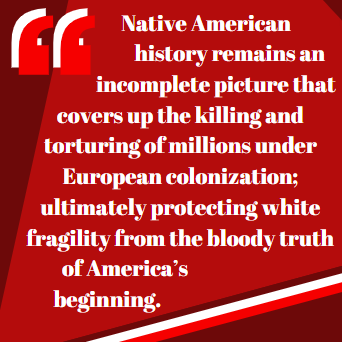By Hannah Kwok
Staff Writer
When hearing the word Thanksgiving, a picture of the American nuclear family gathering hand-in-hand amongst a sea of green beans and gravy may appear, or children, crafting hand turkeys and playing football, all to celebrate the joyous friendship between the settlers and tribes of America’s origins. Yet, for true inhabitants of the land, the Native People of America, the fourth Thursday of November is a grieving period. It is a day marked in remembrance of the lives lost from Indigenous genocide, and the constant assault and exploitation of Native culture and stolen land — eliciting feelings far from gratitude.
Along with the seized territory, betrayal and the holocaust of millions of Indigenous Peoples under white supremacy, most American schools deprive students from the true history of the land they call themselves citizens to. The real backstory behind how America came to be is often ignored and forgotten; instead a rosy glorifying image of colonization replaces it: Pilgrims and Native Americans becoming quick friends amongst a shared meal and golden turkey.
In reality, the first references to Thanksgiving in history are from the journal of American settler William Bradford, dating back to the early 1600s. As the first governor of Plymouth, Massachusetts, Bradford declared a three day celebration to give thanks to their Puritan God for the rain that caused a bountiful harvest. Though Native Americans and Pilgrims did share a meal that day, historians have no record of any invitation given to the Wampanoag tribe. It was because Wampanoag people became infected with diseases brought by European colonizers and had multiple resources stolen from them, that tribal leader Ousamequin proposed an alliance in order to survive. When the Native People heard gunshots and screams from the Plymouth settlements during their celebration, they assumed the cheers were noises of attack, thus sending out 90 Wampanoag soldiers to their aid but soon had joined the feast instead.
In the following harvest years, as more Puritans and British soldiers settled in America, the Native tribes were met with betrayal after Europeans seized their land and either enslaved or executed their people. During the Pequot War of 1637, known as one of the bloodiest Indigenous wars of American history, the Pequot Tribe were shot, clubbed and burned alive as they slept during their annual Green Corn Dance festival. They were slaughtered due to the non-compliance of surrendering their land and fur trade market. The next day, Bay Colony governor John Winthrop memorialized the massacre in triumph, ‘‘A Day of Thanksgiving, thanking God that they had eliminated over 700 men, women and children.”
From then on, Thanksgiving was used to define the marked victories of each elimination of a Native Tribe.
The term soon became popularized when a proclamation was made on Thursday, November 26, 1789, after President George Washington declared the day for ‘public thanksgiving and prayer.’ Over the years, governors and presidents supported the day in celebration until Abraham Lincoln officially established it as the last Thursday of November as ‘a day of Thanksgiving.’
So why did the truth about the real Thanksgiving or the history of Native Peoples in America disappear from the media and mainstream education? Instead, childhood memories include building fourth grade mission projects (the system that oppressed Natives into Catholic faith); watching Disney’s “Pocahontas,” a white-washed narrative romance with love-interest and colonizer John Smith; to learning about Sacagawea as Lewis and Clark’s guide and interpreter but not that she was a kidnapped and child slave. Native American history remains an incomplete picture that covers up the killing and torturing of millions under European colonization; ultimately protecting white fragility from the bloody truth of America’s beginning.
Instead of conforming to a white-washed history and the cultural genocide ideology of Thanksgiving, it is important to participate respectively. With this, it is crucial to practice decolonizing — meaning honoring and supporting Native Peoples by recognizing their land, acknowledging the massacres of Indigenous Americans, and educating yourself and others on Native history and the harmfulness of the Pilgrim/Indian narrative. To support Native Peoples in America, ideas can range from but are not limited to: donating to Indigenous businesses and rights organizations, rebuilding local ecosystems and Native plant species in an earth-friendly manner, to honoring and appreciating Native culture through food, music, dances and more.
To preserve and understand the rich history, heritage and resilience of our nation’s first people, America can become a better and more inclusive country that acknowledges and learns from its mistakes. With this, Thanksgiving should be a time to focus on the core values of gratitude and what it means to cherish community and the importance of identity; it is not a time to celebrate but rather reflect and commemorate those before us.

